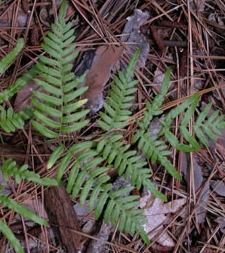Wildlife - Species

Bracken Fern (Pteridium aquilinum)
Description
The bracken fern belongs to the bracken fern family (Pteridaceae). It has a creeping subterranean rhizome that grows up to 3.5 m (11.5 ft) deep, is about 5 mm (2 in) in diameter, and can reach a length of 15 m (49 ft). The fronds are triangular in shape and up to 3 m (10 ft) tall, with lower pinnae (leaflets) nearly opposite on the rachis (stem) and almost dissected. The upper leaflets are alternate on the stem, less dissected and almost entirely near the apex of the fronds. Sori (reproductive organs) are located along the margins of the leaflets. The fiddleheads (developing fronds) are covered with silver-gray hairs and are coiled, unfurling as they grow.
Preferred Habitat and Biology
Bracken fern are found from Virginia to Alabama and West Virginia to Kentucky, primarily on acidic, nutrient-deficient soils. The species inhabits a wide variety of plant communities, including old fields and open areas in forests. Bracken fern is common in pine forests of the ACE Basin.
Growth of existing bracken fern colonies is through asexual reproduction (vegetative growth). During the growing season (July-September), new fronds sprout from the rhizomes, which spread an average of 1 meter, sometimes as much as 2 m (6.5 ft), into the surrounding area. New colonies are started by sexual reproduction. Each year, the ferns produce a crop of spores (seeds) that are dispersed by the wind to other areas. Initially, the developing fiddlehead (new frond) depends entirely on the rhizome's food reserves. As the pinnae (leaflets) develops and unfolds, the frond begin to photosynthesize and eventually no longer needs the rhizome's reserve.
Species Significance
Over the centuries, bracken fern has been used as vermifuge, diuretic, astringent and purgative. The Cherokee Indians used the plant as a tonic, antiseptic and antiemetic, and the Europeans used it to reduce swelling and hardness of the spleen, as well as an ointment for flesh wounds. Today, the astringent chemicals found in the rhizome are used for tanning animal skins. Although many cultures used this species as food, including modern-day wild food enthusiasts, recent studies have shown it to be carcinogenic. Also, this species is not recommended as a food source for cattle and horses since it can cause severe poisoning. The bracken fern is one of the most common fern species throughout the world.
References
Dunbar, L. 1989. Ferns of the coastal plain: Their lore, legends, and uses. University of South Carolina Press, Columbia, SC.
Fletcher, W.W. and R.C. Kirkwood. 1979. The bracken fern (Pteridium aquilinum L. (Kuhn)); its biology and control. p. 591-637. In: A.F. Dyer (ed.). The experimental biology of ferns. Academic Press, London, U.K
Radford, A.E., H.E. Ahles, and C.R. Bell. 1968. Manual of the vascular flora of the Carolinas. The University of North Carolina Press, Chapel Hill, NC.
Watt, A.S. 1976. The ecological status of bracken. Botanical Journal of the Linnean Society 73:217-239.
